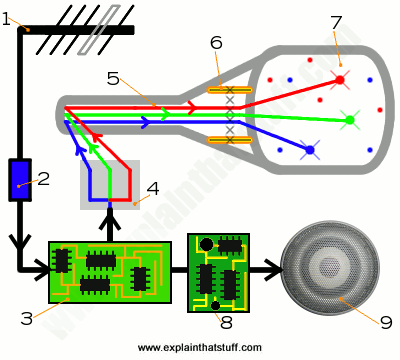CATHODE RAY
CATHODE RAY
How a cathode-ray tube (CRT) TV works

- An antenna (aerial) on your roof picks up radio waves from the transmitter. With satellite TV, the signals come from a satellite dish mounted on your wall or roof. With cable TV, the signal comes to you via an underground fiber-optic cable.
- The incoming signal feeds into the antenna socket on the back of the TV.
- The incoming signal is carrying picture and sound for more than one station (program). An electronic circuit inside the TV selects only the station you want to watch and splits the signal for this station into separate audio (sound) and video (picture) information, passing each to a separate circuit for further processing.
- The electron gun circuit splits the video part of the signal into separate red, blue, and green signals to drive the three electron guns.

- The circuit fires three electron guns (one red, one blue, and one green) down acathode-ray tube, like a fatglassbottle from which the air has been removed.
- The electron beams pass through a ring of electromagnets. Electrons can be steered by magnets because they have a negative electrical charge. The electromagnets steer the electron beams so they sweep back and forth across the screen, line by line.
- The electron beams pass through a grid of holes called a mask, which directs them so they hit exact places on the TV screen. Where the beams hit the phosphors (colored chemicals) on the screen, they make red, blue, or green dots. Elsewhere, the screen remains dark. The pattern of red, blue, and green dots builds up a colored picture very quickly.
- Meanwhile, audio (sound) information from the incoming signal passes to a separate audio circuit.
- The audio circuit drives the loudspeaker (or loudspeakers, since there are at least two in a stereo TV) so they recreate the sound exactly in time with the moving picture.


Good blog post... well done.
ReplyDelete